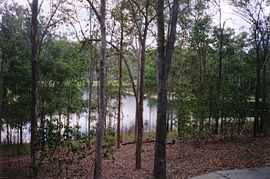Enoggera Dam
| Enoggera Dam | |
|---|---|
 Enoggera Dam (photo taken at Brisbane Forest Park on 23 April 2007) | |
 | |
| Country | Australia |
| Location | 10 km (6.2 mi) West of Brisbane, Queensland |
| Coordinates | 27°26′50″S 152°55′37″E / 27.4473°S 152.927°ECoordinates: 27°26′50″S 152°55′37″E / 27.4473°S 152.927°E |
| Status | Operational |
| Construction began | 1864 |
| Opening date | 1866 |
| Construction cost | ₤71,000 |
| Dam and spillways | |
| Type of dam | clay cored earthfill dam |
| Impounds | Enoggera Creek |
| Reservoir | |
| Creates | Enoggera Reservoir |
| Total capacity | 4,500,000 m3 (3,600 acre·ft) |
| Catchment area | 33 km2 (13 sq mi) |
| Surface area | 358.15 ha (3.58 km2) |
| Max. length | 2,376 m (7,795 ft) |
| Max. width | 640 m (2,100 ft) |
The Enoggera Dam is a heritage-listed dam, which is located within the inner, western suburb of Enoggera Reservoir, in Brisbane, Queensland, Australia.
History
The dam was constructed in 1866. It was built on Enoggera Creek and was the first major dam built in Queensland (it was the second major dam built in Australia — the first major dam, Yan Yean Reservoir having been built in Victoria in 1850).[1] It is rare as one of the few remaining examples in Queensland of an intact and functioning reservoir and treatment plant from this period in time. The clay cored earthfill dam was designed and built by Joseph Brady.[1][2]
Water supply problems plagued Brisbane's early years. Soon after the Brisbane Municipal Council was established in 1860, a Water Supply Committee was formed.[3] The earliest reservoir in Brisbane, which was located at the intersection of the present George Street and Roma Street, suffered from accumulation of dead animals and vegetable matter.[3]
Site selection
Breakfast Creek was rejected by the Water Supply Committee because it was too close to the town.[3] Thomas Oldham, an engineer who had worked on water supply to Melbourne, was employed to conduct a survey and solve Brisbane's problems.
One of Oldham's site recommendations on the Brisbane River near Dutton Park was dismissed before of its prohibitive costs.[3] The other site Oldham suggested was selected because it was where Enoggera Creek left the range.[4] The Surveyor-General, Augustus Gregory also suggested a site on Ithaca Creek. This location was abandoned because it had a small catchment size.
Enoggera Creek had a large catchment that rose higher in the D'Aguilar Range and had more smaller creeks flowing into it.[4] The location was steep and heavily timbered. It took eighteen months and ten different contractors to just clear the site.[4]
Construction

The Queensland Government didn't have confidence in the Council to supervise the dam's construction. After requesting revised plans and detailed cost estimates the Board of Waterworks was established to oversee the project.[3]
Approval for the dam's construction was given in May 1864. Work began in August 1864 with water flowing by July 1866.[5] A single cast-iron mains pipe, 8 inches (20 cm) in diameter, supplied the town of Brisbane. By 1869 the pipelines were extended to a total of eighteen kilometers, benefiting between five to six thousand people.[4]
Three outlet pipes were incorporated into the design instead of the usual one or two.[1] This allowed the potential supply to increase if needed as well as providing some safety benefits.[1]
The original cost was ₤50,000, which was raised to ₤65,000.[5] By the end of 1870 more than ₤71,000 had been spent and water supply for the rapidly growing city of Brisbane was not being met by strong demand. To solve the problem another dam, Gold Creek Dam was approved in 1881.
A commemorative drinking fountain in the City Botanic Gardens is dedicated to the arrival of clean drinking mains water to Brisbane.[1]
Droughts and floods
Dry periods pronounced water quality problems in both Enoggera Dam and Gold Creek Dam built after the Enoggera reservoir was completed. The Mount Crosby Weir and pumping station alleviated some concerns but flooding of the Brisbane River was problematic. It was not until 1912 that water from Enoggera Dam was filtered.[6]
A spillway was added in 1976.[2] Seven metres was added to the height of the dam wall for flood mitigation in the same year.[4]
It was decommissioned in 2003, then in early 2006 water from Enoggera Dam was again added to inner north-west Brisbane's drinking water supply, when drought had reduced South East Queensland's water supply to critical levels.
Current use
The dam was managed by the Brisbane City Council until July 2008, but is now managed by Seqwater.
There are walking tracks in the area, and no permit is required. However, no on-water activities are permitted.[7]
Heritage listing
The dam was listed on the Queensland Heritage Register in 2007.[8]
See also
References
- ↑ 1.0 1.1 1.2 1.3 1.4 Gregory, Helen; Dianne Mclay (2010). Building Brisbane's History: Structure, Sculptures, Stories and Secrets. Warriewood, New South Wales: Woodslane Press. pp. 192—194. ISBN 9781921606199.
- ↑ 2.0 2.1 "Enoggera Reservoir (entry 19580 )". Queensland Heritage Register. Queensland Heritage Council. Retrieved 2009-05-28.
- ↑ 3.0 3.1 3.2 3.3 3.4 Brisbane 150 Stories. Brisbane City Council Publication. 2009. pp. 12–13. ISBN 978-1-876091-60-6.
- ↑ 4.0 4.1 4.2 4.3 4.4 Horton, Helen (1988). Brisbane's Back Door: The story of the D'Aguilar Range. Bowen Hills, Queensland: Boolarong Publications. pp. 74–77. ISBN 0-86439-036-X.
- ↑ 5.0 5.1 Laverty, John (2008). "The politics of Brisbane's early water supply schemes". In Carolyn Fitz-Gerald. Brisbane:Water, Power and Industry Paper No. 20 (Kelvin Grove, Queensland: Brisbane History Group): 23–25. ISBN 978-0-9751793-3-8.
- ↑ Oliver, Bill (2008). "Floods, water quality and river crossings, Mount Crosby 1890-1931". In Carolyn Fitz-Gerald. Brisbane:Water, Power and Industry Paper No. 20 (Kelvin Grove, Queensland: Brisbane History Group): 33. ISBN 978-0-9751793-3-8.
- ↑ "Enoggera Dam". Seqwater. Retrieved 5 June 2013.
- ↑ "Enoggera Reservoir (entry 19580)". Queensland Heritage Register. Queensland Heritage Council. Retrieved 2013-07-06.